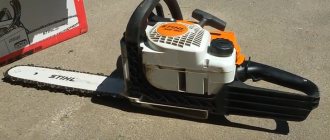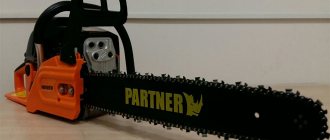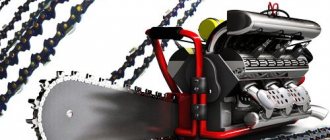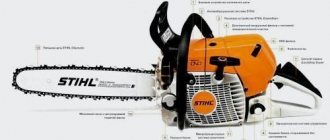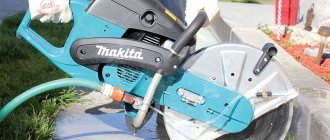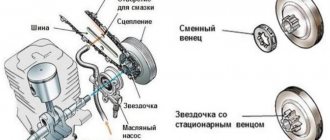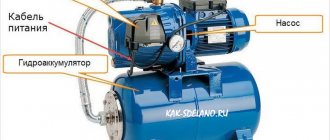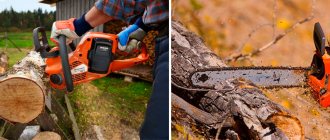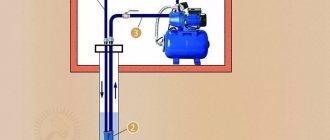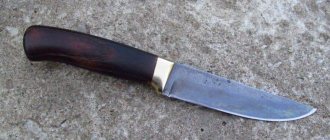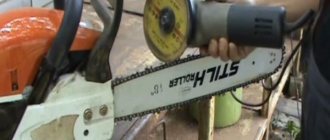Modern chainsaws are rather capricious devices, although their creators use the same technologies in their production. The problem is the materials used. According to independent sources, a tool for cutting wood in the average price category lasts 500-1200 hours, professional devices - up to 2000, and sometimes longer. At the same time, it is important to follow the manufacturer’s recommendations: maintain the equipment in a timely manner, observe a certain operating mode, fill with high-quality fuel and oil.
Causes of chainsaw malfunction
If the chainsaw does not start, then you need to carry out step-by-step diagnostics. It is recommended to go from simple to complex and do everything in order. Although devices from different manufacturers differ from each other, they have the same operating principle and layout: they are based on a two-stroke gasoline engine, which rotates a tensioned cutting chain through a gearbox.
Diagnostics must be carried out sequentially:
- Inspection of filters.
- Checking the electrical system (is there a spark at the spark plug electrode or not).
- Inspection of the fuel supply and breather, which is built into the fuel tank cap.
- Study of exhaust gas channels.
Each of the four stages must be considered separately.
What you will need for repair:
- Set of car wrenches, sockets and sockets.
- Screwdrivers: Phillips and slotted, flat spatulas for cleaning parts.
- Metal brush (cord brush) and brushes with hard bristles.
- A basin for washing parts (a cut plastic canister will do).
It is recommended to use a compressor to blow through engine parts. The use of technical gases (especially oxygen) is prohibited.
Filters
If the chainsaw has been running for a long time, it is possible that the air or fuel filters may become clogged. In the first case, the required portion of air will not enter the cylinders, and combustion of the fuel mixture will not occur. If the fuel system is clogged, the supply of gasoline mixture will stop.
The air-cleaning element should be removed carefully; dust should not get into the carburetor. The element needs to be blown out, washed with soap and water, dried and then reinstalled.
To check the condition of the fuel filter, you need to remove the hose from the carburetor and try to pump fuel manually. If the stream is too weak or completely absent, the filter needs to be replaced or washed. You can purchase a new one from a dealer, or go to a power tool repair shop.
Checking the spark plug
The operation is similar to that carried out by all motorists with gasoline engines. If you have a new and 100% working spark plug in stock, then the easiest way is to install it and try to start the chainsaw. The old one should be inspected: heavy carbon deposits indicate that the engine is not working properly. If there are no deposits, the gap between the electrodes may have broken down, causing the spark to stop forming or to be too dim. The distance between the contacts varies between 0.2-0.5 mm.
Why does carbon deposits form:
- Errors made when adjusting the carburetor.
- Added too much oil to the mixture.
- The air filter was clogged.
The verification algorithm is simple:
- Remove the high voltage wire.
- Unscrew the spark plug and attach the previously removed wire back to it.
- Place the spark plug skirt against the unpainted part of the cylinder.
- Try to start the engine.
You can try to disassemble the ignition unit, clean the contacts, dry it, reassemble it and try again. A number of faults cannot be eliminated, so in some cases the unit will require replacement, but this is a last resort.
Gasoline supply. Breather
One of the most difficult stages of verification.
First you need to prepare your workplace:
- Remove dirt and dust from the workbench.
- Prepare clean rags, brushes, containers for washing small parts.
- If you have a compressor, prepare it to blow through the carburetor channels.
The chainsaw itself needs to be cleaned and blown with compressed air. Now you can start diagnosing.
Check status:
- Fuel tank - there should be no dirt, iron filings, sand or other impurities inside.
- A breather built into the lid - air must enter the tank through it, otherwise a vacuum will be created during operation and fuel will not flow into the carburetor.
- Hoses and tubes - for cracks and other defects. Replace if in any doubt.
After assembly, you need to check: if, as a result of manual pumping with the supply tube removed from the carburetor, the gasoline mixture flows in a dense stream with jerks, then the system is working. If the chainsaw still does not start, then the carburetor is to blame.
Exhaust channels
After prolonged use, the chainsaw's exhaust channels could become coked, causing resistance to the forward movement of the piston. Simply put, gases that are not removed slow down the engine.
How to fix:
- Remove the chainsaw muffler.
- Carefully remove the gasket.
- Remove the spark arrester.
- Disassemble the resonator housing (if possible).
- Clean parts using cleaning solutions (kerosene, WD-40) and mechanically.
- Wipe and dry the knots.
- Put the system back together.
What to do if nothing helps?
If the chainsaw still does not start, and the reasons and solutions could not be identified, then this is a reason to visit the service center. But if it is not nearby, then you can try to perform a number of other actions, all at your own peril and risk.
What other causes of malfunctions could be:
- Low compression ratio in the cylinders - if the compression rings are worn out or deformed, then there is an excessively large gap between them and the cylinder walls. Because of this, the fuel mixture does not burn, but leaks out.
- The carburetor is not adjusted - it’s difficult for an amateur to set up the device correctly, but it’s worth a try.
- Mechanical faults - if before the breakdown you heard extraneous sounds: grinding, clanging, ringing, then the internal parts of the engine are probably damaged. Without experience in overhauling two-stroke engines, it will be extremely difficult to do anything.
Compression is measured using a device of the same name (compression gauge). It is screwed in instead of a spark plug, after which you need to try to “start” the engine. The reading that appears on the dial will be the actual compression value. The nominal value will have to be found in the engine documentation.
If you don’t have a compression gauge, then do this:
- Place your finger on the hole
Proper starting of a chainsaw is one of the most important stages of working with this tool. Sawing productivity, wear of moving elements and the overall duration of operation depend on compliance with the rules. When working with any model, it is important to be able to carry out the first start-up, diagnose the main problems, and also correctly select and fill the fuel mixture. From the article you will learn how to start a chainsaw and check its functionality yourself.
Starting without a starter
Often, many home craftsmen are interested in whether it is possible to power a chainsaw without the help of a starter. The answer is very simple: this cannot be done in principle.
None of the manufacturers have provided other alternative starting methods. Therefore, even if you remove the starter and try to start the car in some other way, it still will not work, since disturbances will occur in the cooling system. This system contains a volute to transmit the flow of cold air from the flywheel impeller towards the cylinder. If it is not there, the engine will overheat and eventually seize.
Read also: How to weld aluminum with an inverter
Chainsaw and two-stroke engine devices
By design, all models of modern chainsaws are a mechanism driven by an internal combustion engine. Usually this is a single-cylinder two-stroke version, which does not have a classic gearbox. Its function is performed by a single-stage chain transmission, which drives the saw set. The main components of the chainsaw design:
- membrane type carburetor;
- ignition;
- fuel system;
- starter;
- air purification unit;
- chain and bar;
- chain brake (contact and inertial);
- tension mechanism;
- Lubrication system.
Figure 1 – External structure of the chainsaw
Chainsaws are equipped with a centrifugal clutch, which operates automatically depending on engine speed. With sufficient power, special elements are pressed against the inside of the drum, setting the drive sprocket in motion. The advantage of such a mechanism is that when the saw jams in a cut, the clutch begins to slip, reducing the risk of breakage of the internal mechanisms.
Important ! The internal combustion engine in chainsaws has a maximum speed of up to 13.5 thousand per minute. The quality of its work directly depends on the fuel mixture and oil.
How to start a chainsaw?
In most European models, the starting system and starter have a similar device and operating mechanism. The exception is old domestically produced chainsaws (Ural, Lesnik). There is a handle on the body through which the cable is passed. If you lift it, the cable engages with the ratchet drum, and several revolutions of the crankshaft occur. At the same time, fuel is released and ignited with the help of a spark plug, after which the chainsaw starts up. To simplify the start, the following mechanisms can be implemented in high-quality chainsaw models:
- installing a damper in the carburetor to pre-enrich the fuel mixture;
- decompression valve, which reduces the operating pressure in the engine cylinder;
- a spring that simplifies the unwinding of the crankshaft while the cable is moving;
- additional pump for pumping fuel (usually found in American manufacturers).
The starter is constantly subjected to dynamic load. Because of this, it can fail at any time right during startup. If the saw is used frequently, it is recommended to carry out preventive maintenance at least once a year. It is recommended that only two people replace the cord in the starter, as it is necessary to securely fix the spring.
Tool launch features
To run the tool, several processes need to happen simultaneously:
it should shrink as much as possible;
Each of these processes occurs the moment you pull the starter handle. When using a new chainsaw, you need to remember to break it in.
However, in reality everything is not so simple.
The fuel for starting the tool in hot and cold engine modes must differ in the quality of the air mixture . So, a hot engine can operate with a normal air level, which will ensure its stable operation and will maintain normal idle speed. However, a similar amount of air will be enough to drive a cold engine. Before starting the chainsaw, the starter will need to be pulled about 10 times and possibly more.
To reduce the amount of air and increase the fuel supply in the chainsaw carburetor, a special damper is installed, which is responsible for adjusting the amount of air when starting the engine . Starting the engine with a saw will be faster, so the duration of operation of the starter and the saw as a whole will be increased.
It is very dangerous to start the saw at a refueling site.
Preparing for launch
Before starting the chainsaw for the first time, you should check the condition of the saw set and the quality of the tension of the bolts on the body. After this, prepare the fuel mixture in the proportion specified by the manufacturer and pour it correctly into the tool tank. You cannot start work without making sure that the device is in full working order - this can lead to breakdown of expensive elements and serious injuries.
Preparing the fuel mixture
For normal operation of the chainsaw, it is recommended to take gasoline with an octane number of at least 90. The best option is AI-92 grade; the use of lower quality fuel can cause engine knocking and a decrease in its productivity.
Two-stroke engine oil is required for both break-in and continuous operation. It is better to purchase brands designed for specific chainsaw models. The proportions for preparing the fuel mixture for each saw are indicated in the operating instructions; on average, it is recommended to mix at a rate of 1:33. For old domestic chainsaws, the mixture is prepared in a ratio of 1:15.
Important ! Leaded fuel is used to refuel chainsaws with engines without a catalyst. Its presence can be identified by the green cap of the gas tank; for models with a catalyst, unleaded gasoline must be filled.
Refueling
It is recommended to prepare the dressing mixture in a metal container. First, pour the required amount of oil, and then dilute it with gasoline and bring until smooth. Carefully pour the prepared mixture into the chainsaw tank, being careful not to stain the body, and screw the cap tightly. The finished mixture can be stored for no more than 30 days, after which the oxidation process starts. At the same time as refueling, it is recommended to check the oil tank for chain lubrication and top it up if necessary.
Checking chain tension
To check the tension of the chain on the saw set, just pull it with your fingers in the middle part of the bar. The link shanks, when installed correctly, should not extend out of the grooves by more than a third of the length. The chain should move smoothly along the tire without much effort; if movement is difficult, the tension should be loosened.
Figure 3 – Checking chain tension
It is easy to regulate the voltage of this element in chainsaws yourself using a special wing bolt on the body. Some models have two bolts, less often a tightening wrench is required - before starting operation, you should carefully read the instructions.
How to turn on a chainsaw?
After preparing the tool for sawing and filling the fuel tank, you can proceed directly to start-up. It should be remembered that after purchasing a chainsaw, a run-in is required - starting at idle, cutting wood (up to 10 cm in diameter) at medium speed. Foreign models reach full power after 5-7 tanks have been used up; old domestic saws are run in at partial load for 24 hours (3-4 full refills). During this period, it is strictly forbidden to heat the engine, allow prolonged idling, or apply maximum loads when sawing.
Launch stages
After all checks, you can run the tool for further work. To do this, the saw must be placed on a stable surface so that the bar does not touch the ground. Step-by-step algorithm:
- Disengage the chain brake using the handle on the body of the chainsaw.
- Turn on the ignition by pressing the button or switch (usually the leftmost position).
- Move the air supply damper to the closed position. Pull out the throttle lever and lock it in an intermediate position.
- Take the front handle with your left hand and press it lightly to the bottom. Step on the protective shield of the right handle with your foot.
- With your other free hand, you plan to pull the starter handle towards you until the pawls in the ratchet mechanism engage the drum clutch. Make a sharp jerk.
- After the first flash in the ignition chamber, turn the air damper to its original position. Start the saw again.
Once the engine starts, give full throttle and release the throttle lever completely. Normally, the trigger unit should automatically turn off.
Start according to instructions
Different models of chainsaws have their own starting features and their own mechanisms. We will look at the device startup algorithm using the example of the popular Stihl MS 180 chainsaw model.
Before starting the startup process, it should be noted that the instructions for some chainsaw models state that before starting the tool, you should apply the emergency stop brake to ensure additional safety. But with a fixed brake, starting will be more difficult .
Accordingly, it will be better to unfix it.
If you do everything correctly, then nothing will be difficult. If you are worried that without fixing the chainsaw at the moment of starting it will cause harm, then it is better not to take risks at all and not get to work. So, the algorithm for launching the Calm tool is as follows:
- Before starting to wind the tool, the damper adjustment lever should be moved to the lower position. Remember that it moves all the way down on the saw only when the gas button is pressed. Press the gas button and move the lever down. This will close the carburetor valve and lock the gas in the pressed position;
- Next, vigorously pull the starter handle until you hear the characteristic sound of an attempt to start the tool. It should stall immediately. Then the damper position adjustment lever is moved one step up;
- In this position, pull the starter handle again until the saw starts. And if it starts, then due to the fact that the gas handle is fixed pressed, the work will take place at high speeds;
- Then press and release the gas button once so that the throttle adjustment lever automatically assumes the operating position and the speed decreases;
- If it is necessary to put a heated chainsaw into operation, you need to put the lever in the working position and then start it;
- To stop the machine's engine, the throttle adjustment lever must be moved to the up position.
What to do if the chainsaw does not start?
There are many factors why a chainsaw will not start if the starting technology is followed. The most common causes and ways to eliminate them:
- there is no spark on the spark plug - replacement or drying is required if water gets in;
- problem with the supply of gasoline to the filter - blowing out the fuel hose or filter, replacing;
- If the fuel or air filter is clogged , proper cleaning is required.
If these simple tips do not help, you need a full diagnosis of the problems. It is recommended to take the chainsaw to a service center, where they can check the compression of the cylinder and crankcase, as well as the operation of the carburetor.
Proper starting of the chainsaw ensures stable and reliable operation of this tool. When starting, before starting sawing, you should properly prepare and fill the fuel mixture and adjust the main structural elements. It is important to take into account weather conditions, as well as the features of a particular model.
How to start a chainsaw engine after a long break
Starting and stopping the motor of the MP-5 "Ural-2T Electron"
a) Open fuel valve 4 (drawing 10) by turning the valve lever parallel to the fuel line fitting.
b) At the first start in a different way after a long break in working with a chainsaw, fill the carburetor with fuel, for which purpose press the enrichment button 4.5 (draft 16) until drops of fuel appear from the carburetor (in this case, the chainsaw must be tilted towards the carburetor).
c) Close the carburetor air damper, turn its lever 3 (sketch 15) to the upper or lower position in full.
d) Install and secure the starter on the chainsaw.
e) Start the engine and perform the following steps:
Read:
— take the chainsaw with your left hand by the right handle, pressing the gas control lever all the way;
— placing your left foot on the engine body, sharply pull the starter cable towards yourself by the handle, turning the engine crankshaft;
— after the first flash of working consistency in the cylinder, open the air damper and continue starting.
It is allowed to use the following technique when starting the engine: hold the chainsaw by the right handle with your left hand, pressing the throttle
, place the knee of your left leg on the left handle of the frame, and with your right hand sharply pull the starter cable,
turning
the engine crankshaft.
Why doesn't the Stihl saw start?
The principle of starting the unit consists of a chain of interconnected processes. If one link in the chain fails or is missing, this not only negatively affects the operation of the equipment, but can also lead to its breakdown or problems starting the device.
Operation of the tool involves the following steps:
- Supply of compressed fuel mixture. It is needed for the engine to operate;
- Spark supply. Necessary for ignition;
- The launch and operation of the device is a consequence of previous processes.
If, despite the procedure described in the instructions, the unit does not start, it means that one of the processes has been disrupted in one of the chain links.
Reasons why a chainsaw may not start:
- Malfunctions associated with the fuel system: low fuel quality, lack of fuel mixture supply.
- Clogged main filter elements. A dirty gas filter prevents the supply of fuel to the carburetor of an internal combustion engine, which immediately negatively affects the operation of the equipment. A clogged air filter, in turn, cannot provide a full supply of air, without which the engine cannot be started.
- No spark. The reason for this may be a poor quality or damaged spark plug.
- Engine overheating.
Monitor the quality and correct proportions of the fuel mixture. The presence of water or large amounts of oil in the fuel can cause malfunction or problems starting garden tools. The optimal shelf life of the gasoline-oil mixture is 1 month, after which coking resinous deposits form in it, which negatively affect engine performance.
If the saw does not start when you first try to start it, you can first stop it for 10 minutes, then try to start the unit again. If trying again does not work, you will have to look under the body of the garden machine: check the condition of the filters, inspect the carburetor and spark plug. You should try to clean dirty filters, rinse them in soapy water, and then dry them. Running filters will have to be replaced. If the spark plug is wet and does not produce a spark, you can try to dry it, but it is advisable to replace it too.
How to start a chainsaw without a starter?
We tell and show how to start chainsaws
using the Husqvarna 140 and Stihl 170 as examples.
NOTE—If the engine is overfilled with fuel, it becomes difficult to start.
Read:
A sign of overflow is the absence of a flash of working mixture in the cylinder and the presence of fuel mixture on the spark plug electrodes. Then you need to blow out the engine by turning the crankshaft with the spark plug turned out and the air and throttle valves open, then wipe the spark plug dry, place it in the area and continue starting the engine.
Starting Shtil 180
To start a chainsaw
Shtil 180 when cold, you must follow the algorithm specified by the manufacturer in the instructions for the Shtil 180 chainsaw, namely:
- Turn on the ignition and set the engine control lever to the lowest position (in this position, the air damper of the Stihl
180 carburetor blocks the access of air from the air filter, and the throttle is fully open, thus enriching the fuel mixture); - Pull the starter handle several times until the first flash passes (the flash indicates that the fuel mixture has entered the cylinder and the saw is ready to start);
- Set the control lever one position up from fully lowered (in this position the air damper opens and the throttle remains in the same position as before);
- Pull the starter and start. The saw will start and operate at higher speeds, due to the fact that the throttle valve is maximally open. To set the throttle to idle mode, you need to press the gas trigger and immediately release it, the tool will immediately normalize the speed.
KEY-DOP
The Stihl MS 180 chainsaw does not come standard with any additional devices that can make starting easier.
Below you can see how to start a calm 180. Video
reflects in detail all the main points, and the author allows you to understand the entire process down to the smallest detail.
Starting the Stihl MS 211 C-BE
The fuel supply system in the Stihl MS 211 C-BE chainsaw is additionally equipped with a manual fuel pump, which makes it easier to start the chainsaw when cold.
The instructions for starting this Calm chainsaw model contain one additional point, which is that before starting the chainsaw when cold, you need to pump fuel into the carburetor using a pump. Further, the instructions are no different from launching calm 180 and follow the same algorithm.
What happens when the primer pumps fuel, and how does this help start the saw more efficiently?
At the moment of starting the saw without a primer, several movements of the starter are carried out only so that the fuel pump, under the influence of an impulse from the saw crankcase, pumps fuel into the carburetor.
A pump installed in the fuel line allows you to manually pump gasoline into the carburetor without unnecessary movements of the starter. The effect of this action is obvious; the saw will start much faster.
Many owners of gas-powered tools mistakenly believe that using a hand pump can over-pump fuel into the carburetor and for this reason the spark plug will flood. This is fundamentally wrong, since the system is capable of circulating in a circle. Excess gasoline from the carburetor will be directed through a special hose designed for this purpose back into the tank.
There is no need to use a primer on a hot chainsaw, since the fuel in the carburetor is sufficient for starting.
Related Posts
Not all beginners who pick up a chainsaw for the first time in their lives have any idea how to start it. How to start a chainsaw correctly. Meanwhile, experience shows that it is at the moment of engine start that accidents occur.
A good selection of stihl chainsaws in Zhitomir is available at the best price. How to start a saw after a long period of inactivity It is much easier to start a chainsaw through. How to start a chainsaw and you can start it. How to properly wind fishing line onto a reel. You can purchase a quality instrument even if you are in another city. In this publication we will talk about the two most common methods.
Review of the MS 180 chainsaw
This equipment model costs RUB 11,490. It is a household tool that will help you cope with work on your summer cottage. With the help of the unit you can get rid of unnecessary branches and cut down small trees. The control is single-lever, and thanks to its light weight, working with the unit is very comfortable.
The consumer should know not only how to start the Shtil ms 180 chainsaw, but also about the technical characteristics. Among others, it is worth highlighting the 35 cm tire, as well as the engine, the volume of which is 31.8 cm3. The volume of the oil tank is 0.15 l. The equipment weighs 3.9 kg. The power of the model is 2 liters. With. The fuel tank capacity is 0.25 liters.
The safest way
This method of starting a chainsaw is suitable for those who have never worked with a chainsaw before. What to do if you can’t start a chainsaw chainsaw like this husqvarna before. The point is this. It is strongly recommended that you do the following steps in order:
- place the chainsaw on a flat surface (the floor);
- We place our right foot in a technological support;
- We place our left hand on the chainsaw handle;
- turn on the ignition;
- pumping gasoline;
- pull out the choke;
- with a sharp movement we pull the starting rope.
